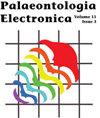Evaluating the ecology of Spinosaurus: shoreline generalist or aquatic pursuit specialist?
IF 1.5
4区 地球科学
Q1 Earth and Planetary Sciences
引用次数: 23
Abstract
The giant theropod Spinosaurus was an unusual animal and highly derived in many ways, and interpretations of its ecology remain controversial. Recent papers have added considerable knowledge of the anatomy of the genus with the discovery of a new and much more complete specimen, but this has also brought new and dramatic interpretations of its ecology as a highly specialised semi-aquatic animal that actively pursued aquatic prey. Here we assess the arguments about the functional morphology of this animal and the available data on its ecology and possible habits in the light of these new finds. We conclude that based on the available data, the degree of adaptations for aquatic life are questionable, other interpretations for the tail fin and other features are supported (e.g., socio-sexual signalling), and the pursuit predation hypothesis for Spinosaurus as a “highly specialized aquatic predator” is not supported. In contrast, a ‘wading’ model for an animal that predominantly fished from shorelines or within shallow waters is not contradicted by any line of evidence and is well supported. Spinosaurus almost certainly fed primarily from the water and may have swum, but there is no evidence that it was a specialised aquatic pursuit predator. David W.E. Hone. Queen Mary University of London, Mile End Road, London, E1 4NS, UK. d.hone@qmul.ac.uk Thomas R. Holtz, Jr. Department of Geology, University of Maryland, College Park, Maryland 20742 USA and Department of Paleobiology, National Museum of Natural History, Washington, DC 20560 USA. tholtz@umd.edu评估棘龙的生态:海岸线专家还是水生追捕专家?
巨型兽脚亚目棘龙是一种不同寻常的动物,在许多方面都有高度的起源,对其生态学的解释仍然存在争议。随着一个新的、更完整的标本的发现,最近的论文增加了对该属解剖学的大量了解,但这也为其生态学带来了新的、戏剧性的解释,因为它是一种高度专业化的半水生动物,积极捕食水生猎物。在这里,我们根据这些新发现,评估了关于这种动物功能形态的争论,以及关于其生态学和可能习性的可用数据。我们得出的结论是,根据现有数据,对水生生物的适应程度值得怀疑,对尾鳍和其他特征的其他解释得到了支持(例如,社会性别信号),棘龙作为“高度专业化的水生捕食者”的追逐-捕食假说不受支持。相比之下,主要从海岸线或浅水区捕鱼的动物的“涉水”模型没有与任何证据相矛盾,并且得到了很好的支持。几乎可以肯定的是,棘龙主要从水中进食,可能会游泳,但没有证据表明它是一种专门的水生捕食动物。David W.E.Hone。伦敦玛丽女王大学,Mile End Road,伦敦,E1 4NS,英国。d.hone@qmul.ac.ukThomas R.Holtz,Jr.马里兰大学地质系,美国马里兰大学帕克分校,邮编:20742,美国华盛顿特区国家自然历史博物馆古生物学系,邮编:20560。tholtz@umd.edu
本文章由计算机程序翻译,如有差异,请以英文原文为准。
求助全文
约1分钟内获得全文
求助全文
来源期刊

Palaeontologia Electronica
地学-古生物学
CiteScore
3.60
自引率
0.00%
发文量
20
审稿时长
>12 weeks
期刊介绍:
Founded in 1997, Palaeontologia Electronica (PE) is the longest running open-access, peer-reviewed electronic journal and covers all aspects of palaeontology. PE uses an external double-blind peer review system for all manuscripts. Copyright of scientific papers is held by one of the three sponsoring professional societies at the author''s choice. Reviews, commentaries, and other material is placed in the public domain. PE papers comply with regulations for taxonomic nomenclature established in the International Code of Zoological Nomenclature and the International Code of Nomenclature for Algae, Fungi, and Plants.
 求助内容:
求助内容: 应助结果提醒方式:
应助结果提醒方式:


